Where: Various Locations
When: All times of the day, sunny, rain and dull weather.
How: I had a good think about what would make good horizontal and vertical subjects for the photographs. At visiting some of the sites and doing a quick test shoot, I discounted some of the ideas as either they just did not work or that they failed to express the concept enough.
I used various cameras on this exercise and some of the shots are hand held and others are from a tripod.
I am finding that I’m seeing a tripod as less of a nuisance and more of a compositional tool, allowing me to walk around the subject and allowing me time to examine the subject in the viewfinder.
Horizontal
I went looking for subjects which would express the concept of horizontal either an actual or artificial horizon to the point of view of the viewer.
The first is quite simply a barrier gate, which locks off a piece of road leading down to a lifeboat. The barrier quite literally cuts a horizon across your point of view mainly due to its location and its colour.
D80 Aperture f/14 Shutter Speed 1/40 ISO 160 70mm (35mm equivalent 105mm)Pattern Metering Mode, Auto White Balance, Tripod Mounted.
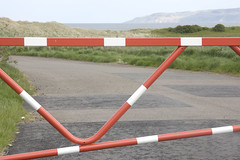
The next was quite obviously an actual horizon; I tried using the rule of thirds to locate the horizon quite far up the frame, as this allowed a good bit of the foreground to be seen and to lead the eye into the frame.
D80 Aperture f/11 Shutter Speed 1/250 ISO 160 70mm (35mm equivalent 105mm)Pattern Metering Mode, Auto White Balance, Hand Held.
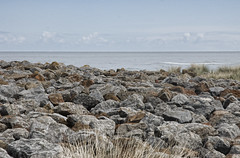
I saw these railings as I was planning to use them as an example of vertical, taken side on. However I changed my mind and photographed them from the side, I tried to get the repeating elements of the horizontal handrails. The horizontal line is also reapeated in the background in the horizon and in the horizontal break in the clouds.
D40x IR Conversion (630nm) Aperture f/10 Shutter Speed 1/125 ISO 200 62mm (35mm equivalent 93mm) Pattern Metering Mode, Preset White Balance (colour corrected in Photoshop) Hand Held.
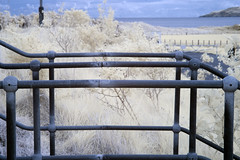
I quite like the fact that the railings have kept some of their colour and that the corrosion on the railings can be clearly seen.
While walking around the quarter mile in Edinburgh, I came across the front of this building while looking at the side of it. A friend of mine, Rob, was the architect on the building and I originally went along to photograph the cladding that he had put on the side of the building.
I liked the repetition of the screen as the rails/bars run in front of the windows.
D40x IR Conversion (630nm) Aperture f/9 Shutter Speed 1/100 ISO 200 70mm (35mm equivalent 105mm) Pattern Metering Mode, Preset White Balance (colour corrected in Photoshop) Hand Held.
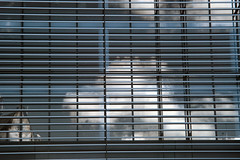
I like the fact that you get a reflection of part of the building behind and the definition of the cloud.
After looking at the notes, I thought I would add a few extra ideas that I had for horizontal
- A Gate at wide
- A Street sign/arrow
- A bridge from below
- The bank of a river looking down into the river.
Vertical
Again for this exercise, I went looking for subjects which would express the concept of vertical either by dominating the point of view by size or by having one or more elements pointing straight up/down.
I tried not to orientate the camera into portrait mode for this part of the exercise, although I did for this photograph.
I liked the shape of these metal benches and they were located in a quiet area, so I was able to sit and examine the area through the viewfinder before taking the final photograph. I took this in both colour and IR. I decided on the IR version as it better defined the surface of the benches. The vertical line in this case is created by the benches leading off up into the frame
D40x IR Conversion (630nm) Aperture f/9 Shutter Speed 1/200 ISO 200 22mm (35mm equivalent 33mm) Pattern Metering Mode, Preset White Balance (colour corrected in Photoshop) Hand Held
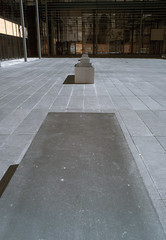
This was one of the first photographs I took for this exercise. I found this quite a compelling subject and decided to slowly frame it up. The first photo I took, the flagpole and the top of the church were too small in the frame. I moved closer and took a version where it was better defined in the frame. I went for the vertical line of the flagpole and the repeating horizontal lines of the tops of the columns.
D80 Aperture f/9 Shutter Speed 1/500 ISO 160 300mm (35mm equivalent 450mm) Pattern Metering Mode, Auto White Balance, Tripod Mounted.
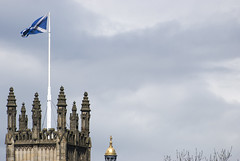
I had this idea quite early on, but with a different set of railings in mind, however when I saw the repeated colour of the railings in the trees in the background I decided to go with these railings instead. I went for the straight up and down lines of the railings to represent the vertical lines for this image.
D50 Aperture f/1.8 Shutter Speed 1/1000 ISO 200 50mm (35mm equivalent 75mm) Pattern Metering Mode, Auto White Balance, Hand Held
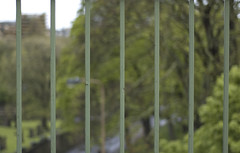
I’m not too sure about this last example, it worked better in my mind than it did when I took the photograph. The repeating vertical white blinds of this building were quite eye catching and I found that it lead me to look up and down the building front rather than across it so I used that as the idea of presenting the vertical lines within the frame.
D80 Aperture f/4.5 Shutter Speed 1/800 ISO 160 70mm (35mm equivalent 105mm) Pattern Metering Mode, Auto White Balance, Hand Held

It was not until I had uploaded the photograph that I noted the step shape reflection of the buildings opposite.
Other ideas for vertical included.
- Stream of water running from a tap – slow shutter speed to indicate movement
- Row of supporting fence railings – wide aperture to define them from the background
- Large glass or steel fronted building – wide angle (perhaps)
- A row of trees in a meadow
- Either a single or a row of flagpoles
I learned a lot from this exercise, mainly to do with looking at subjects with a different point of view, looking for unusual ways of presenting or breaking up the frame. I also learned that I do not have to rely on the orientation of the camera when I want to portray certain concepts and ideas.
I also learned that a tripod is not a hindrance, but a benefit when composing.
No comments:
Post a Comment